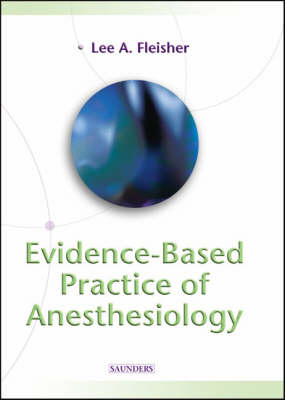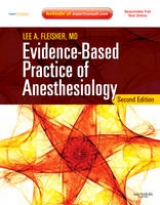
Evidence-Based Practice of Anesthesiology
W B Saunders Co Ltd (Verlag)
978-0-7216-9409-2 (ISBN)
- Titel erscheint in neuer Auflage
- Artikel merken
This practical decision-making tool provides concrete, evidence-based guidelines on all aspects of clinical anesthesiology, including preoperative assessment, monitoring and administration of anesthesia during surgery, postoperative intensive care management, and postoperative pain management. Readers will find reliable, up-to-date therapeutic recommendations based on the most recent clinical trials. Coverage encompasses both routine care and complicated and special situations. What's more, tables summarize available literature at a glance.
Section 1:Preoperative Preparation 1.Does routine testing effect outcome? 2.Should preoperative hemoglobin always be obtained? 3.Is routine pregnancy testing necessary? 4.Is preoperative screening clinic cost-effective? 5.Who should have a preoperative 12-lead electrocardiogram? 6.When should pulmonary function tests be performed preoperatively? 7.Does the airway examination predict difficult intubations? 8.What is the optimal evaluation of the patient with obstructive sleep apnea? 9.Is there an optimal timing for smoking cessation? 10.Does Prophylactic coronary revascularization reduce cardiac complications? 11.Should all anti-hypertensive agents be continued before surgery? 12.Should patients with asthma be given preoperative medications including steroids? 13.Is authologous predonation cost-effective? Section 2:Perioperative Management 14.Does a history of difficult intubation necessitate awake airway management? 15.Patients with difficult airways: regional versus general anesthesia 16.Is there an ideal approach for the MH-susceptible patient? 17.What is the optimal perioperative management for latex allergy? 18.What reduces the risk of aspiration? 19.What is the optimal treatment for aspiration? 20.What is the best strategy to prevent PONV? 21.Does the choice of fluid matter in major surgery? 22.Does the choice of muscle relaxant effect outcome? 23.Is perioperative hypothermia detrimental? 24.When should perioperative glucocorticoids be administered? 25.Should beta adrenergic blocking agents be given rountinely in noncardiac surgery? 26.Should beta adrenergic blocking agents be given routinely in noncardiac surgery? 27.Are alpha- 2 agonists effective in reducing perioperative cardiac complications? 28.Does perioperative hyperglycemia increase risk? 29.What is the best means of preventing perioperative renal dysfunction? 30.What works in a patient with acute repiratory distress syndrome? 31.Is there an optimal perioperative hemoglobin? 32.Is isovelemic hemoditultion cost effective? 33.What drugs increase postoperative bleeding? 34.Fondaparinux: What is its efficacy and safety in surgical patients? 35.Can we prevent recall during anesthesia? 36.What actions can be used to prevent peripheral nerve injury? 37.Is one general anesthetic technique associated with faster recovery? 38.Does anesthetic choice effect surgical and recovery times? 39.What criteria should be used for discharge after outpatient surgery? 40.What is the optimal intra and postoperative management of the obstructive sleep apnea patient? 41.Do intensivists in the ICU improve outcome? Section 3:Regional Anesthesia 42.Is regional superior to general for hip surgery? 43.Should spinal anesthesia be performed in patients with multiple sclerosis? 44.Is regional anesthesia safe in the patient on anti-platelet agents? 45.Does regional anesthesia decrease perioperative blood loss? 46.Do additives (epinephrine, bicarbonate, clonide) improve the onset and quality of peripheral nerve blocks? 47.The best approaches to prophylaxis against DVT formation when using a combination of neuraxial anesthesia and the heparins 48.Vitamin K Antagonists and Spinal Axis Anesthesia 49.Herbal Medications and Spinal Axis Anesthesia 50.What is the optimal management of the post-lumbar puncture headache? 51.What is an epidural blood patch indicated? 52.Is regional anesthesia appropriate for outpatient surgery? Section 4:Monitoring 53.Does a PA cather influence outcome in noncardiac surgery? 54.Does electrophysiologic monitoring effect outcome? 55.What is the best method of diagnosing perioperative myocardial infarction? Section 5:Cardiovascular Anesthesia 56.Is OPCAB superior to CABG? 57.Is fast-tracking for cardiac surgery safe? 58.What should be done first, a CABG or a CEA or should both be done together? 59.Is regional superior to general anesthesia for peripheral vascular surgery? 60.Is there a difference in perioperative morbidity and mortality in patients undergoing carotid endarterectomy with local versus general anesthesia? Section 6:Neurosurgical Anesthesia 61.When is it safe to operate after a stroke? 62.Is there a best technique in the patient with increased intracranial pressure? Section 7:Obstetrical Anesthesia 63.Does labor epidural analgesia effect labor outcome? 64.Anesthesia for cesarean section: regional or general? 65.Does anesthesia increase the risk to the parturient undergoing non-obstetric surgery? Section 8:Pediatric Anesthesia 66.Should succinylcholine be used in children? 67.How young is the youngest infant for outpatient surgery? 68.Should a child with an URI undergo surgery? Section 9:Pain 69.Is pre-emptive analgesia clinically effective? 70.Is epidural analgesia superior to IV-PCA? 71.Benefits and efficacy of postoperative pain treatments?
| Erscheint lt. Verlag | 25.6.2004 |
|---|---|
| Zusatzinfo | Illustrated |
| Verlagsort | London |
| Sprache | englisch |
| Maße | 216 x 276 mm |
| Gewicht | 1090 g |
| Themenwelt | Medizin / Pharmazie ► Medizinische Fachgebiete ► Anästhesie |
| ISBN-10 | 0-7216-9409-8 / 0721694098 |
| ISBN-13 | 978-0-7216-9409-2 / 9780721694092 |
| Zustand | Neuware |
| Informationen gemäß Produktsicherheitsverordnung (GPSR) | |
| Haben Sie eine Frage zum Produkt? |
aus dem Bereich



